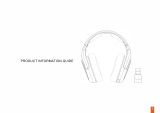
14
8 Using more of your
Bluetooth stereo headset
8.1 Learn about the battery status
Immediately after turning the headset on, the
LED will indicate the battery status.
LED behaviour Battery status
3x red blinking Less than 25% battery
remaining
2x red blinking Less than 50% of charge
remaining
1x blue blinking 50% or more of charge
remaining
The LED will continuously flash red with about 5
minutes of talk time remaining. You will also hear
two short beeps every minute to remind you to
end the call or transfer it to your phone before
the battery runs out.
8.2 Learn about simultaneous use for
voice and audio
Your Bluetooth stereo headset can connect to
• one Bluetooth audio device (supporting the
A2DP and AVRCP Bluetooth profile) and
• one Bluetooth communication device
(supporting HFP or HSP Bluetooth profile) at
the same time.
Therefore you can connect your Bluetooth
stereo headset.
• with a Bluetooth stereo enabled phone to
both listen to music and lead calls, or
• with a Bluetooth phone that does not
support Bluetooth stereo (A2DP) to lead
calls and at the same time to a Bluetooth
audio device (Bluetooth enabled MP3 player,
Bluetooth audio adapter etc.) to listen to
music. Make sure to pair the phone first
with your Bluetooth headset, then turn both
the phone and headset off to then pair the
Bluetooth audio device.
With the SwitchStream feature you can listen to
music and monitor your calls at the same time.
Even while listening to music, you will hear a ring
tone when receiving a call and can switch to the
call simply by tapping the
button.
8.3 Learn about FullSound
FullSound is a smart digital sound enhancement
algorithm, which runs on a powerful processor
inside your Bluetooth headset.
It restores and enhances bass, treble, stereo
effects and dynamics of compressed music
and leads to a more natural, “real life” sound
experience based on years of acoustic research
and tuning.
The FullSound feature decreases music playing
time by less than 10% if activated. The feature
is activated when you buy the product, to
turn FullSound off or on hold
and
simultaneously for 4 seconds. You will hear one
short beep after turning FullSound on, and two
short beeps after turning FullSound off.


















